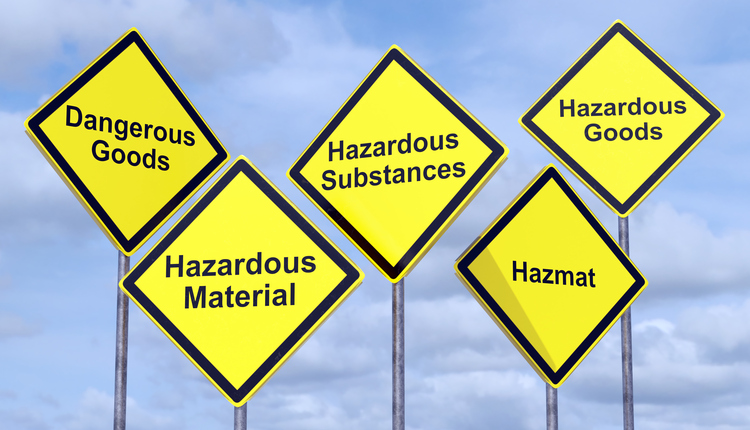Hazardous materials can be defined as materials that are acidic, caustic, combustible, corrosive, explosive, flammable, infectious, poisonous, radioactive, toxic, and volatile. Some items that you might not think are hazardous, but are, include auto and aircraft parts that may have traces of fuel embedded in them. Computer equipment may contain batteries or magnets, cosmetics may be made of flammable liquids, dental equipment may have hazardous solvents, frozen food may contain dry ice, and household goods may contain many dangerous items, such as spray cans under pressure.
Shippers cannot afford to gamble on non-compliance and must have extensive record-keeping abilities on what they are shipping, gathering documentation from suppliers, and from their finished goods processes, that must be included with shipments. This creates masses of paper. If you are audited, the auditors have to look through this documentation, which is typically haphazardly stored.
Shipping chemicals, pharmaceuticals, and other hazardous materials is subject to scrutiny by the government because businesses must meet strict regulations. Companies need to understand these regulations, which are constantly changing, adding to the already challenging transportation requirements.
Those businesses that operate globally are subject to even more regulation based on specific industry and country regulatory policies, requiring extensive governance of ongoing trade compliance programs. If a process manufacturer ships a product with missing documentation or without the correct documentation, a substantial and costly non-compliance fine is imposed.
Penalties for violating federal hazardous material transportation law average around $75,000 and up. If you knowingly violate the laws and regulations that result in death or serious injury to a person or destroy property, the fine can be over $175,000. One chemical company shipped undeclared hazardous materials on an aircraft, which resulted in a fine of $325,000.
The International Air Transport Association (IATA) recently issued new regulations for shipping hazardous materials via airlines which went into effect January 1, 2020. The updated list of regulations includes a new list of hazardous goods, updated packaging requirements and instructions, and clarification of labels and markings.
Hazardous Materials Paperwork
Carriers transporting hazardous materials must have appropriate documentation which includes emergency response information in case of an accident. The paperwork provides details on what is being transported, including the ID number, shipping name as identified in the Hazardous Shipping Table from the DOT, the hazard class, quantity, type of packaging, etc.
The Electronic Code of Federal Regulations (e-CFR) provides special provisions for shipping hazardous materials, such as radioactive materials, hazardous waste, environmentally hazardous materials, and more. Special markings must be displayed on packages containing lithium batteries.
Certificates of Analysis (CoA) are often required when shipping manufactured products. CoAs confirm that a regulated product meets its product specifications. CoAs are typically generated by the quality assurance department within an organization.
Hazard Communication Standards
Chemical manufacturers, distributors, and importers must provide Safety Data Sheets (SDS), formerly Material Safety Data Sheets for each hazardous product that is shipped. SDS contain information on the properties of each chemical; instructions and precautions for handling, storing and transporting chemicals; first-aid and fire-fighting information; exposure control limits; and more.
When operating in a coordinated manner, brand reputation risks are minimized by recalls or customer complaints while improving customer service. Advance Ship Notices (ASNs) tied to material shipments with their e-COA and batch records provide lot and serial number traceability. Product genealogy based on parent and child relationships is enabled by tracking ingredient and component lot mixing at every step. Combined with the shipment criteria, complete supply chain visibility is achieved for both inbound and outbound material movements and product quality.
Manufacturers often log plant floor data on clipboards and store it in binders. When required action or data is missed, downstream problems can occur. Auditors have to look through tons of paperwork when performing an audit, which can be slow and stressful. If paper was eliminated from business processes, the entire regulatory compliance process would be smoother, faster, and more reliable.
Automate to Eliminate Paperwork
Digitizing audit information fosters traceability and tracking of documents needed for trade, including material quality data sheets, import/export certificates, and more. Ensuring receipt of COAs and other regulatory compliance documentation has made digitization a requirement for shippers of hazardous materials. A digital transformation of the supply chain is needed to integrate quality attributes into the products people buy, move, and sell through the supply chain. These opportunities sustain a competitive edge.
Companies that embark on a digital transformation can use a digital supply network to automate business processes and connect a constant flow of information between suppliers, buyers, shippers, and logistics service providers. The information is collected, rationalized, and correlated across business processes and then extended to all trading partners. Streamlining communication among suppliers, customers, and manufacturing sites creates an enterprise-wide quality and compliance solution that minimizes costly product quality issues.
This article originally appeared in the July/August, 2020 issue of PARCEL.












